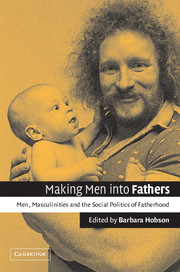Book contents
- Frontmatter
- Contents
- List of figures
- List of tables
- Preface
- Introduction: making men into fathers
- Part 1 Who fathers?
- Part 2 Men in social policy and the logics of cash and care
- Part 3 Resisting and reclaiming fatherhood
- 7 Making sense of fatherhood: the non-payment of child support in Spain
- 8 The Fatherhood Responsibility Movement: the centrality of marriage, work and male sexuality in reconstructions of masculinity and fatherhood
- Part 4 Theorizing men, masculinities and fatherhood
- Notes
- References
- Index
7 - Making sense of fatherhood: the non-payment of child support in Spain
Published online by Cambridge University Press: 22 September 2009
- Frontmatter
- Contents
- List of figures
- List of tables
- Preface
- Introduction: making men into fathers
- Part 1 Who fathers?
- Part 2 Men in social policy and the logics of cash and care
- Part 3 Resisting and reclaiming fatherhood
- 7 Making sense of fatherhood: the non-payment of child support in Spain
- 8 The Fatherhood Responsibility Movement: the centrality of marriage, work and male sexuality in reconstructions of masculinity and fatherhood
- Part 4 Theorizing men, masculinities and fatherhood
- Notes
- References
- Index
Summary
During the transitional years toward Spanish democracy, encompassing the time from the death of Franco in November 1975 to the electoral victory of the socialists in October 1982, legal reforms affecting the family were made. There are two important moments in this reform process. The first was in 1978 with the promulgation of a democratic Constitution, where equality between women and men was explicitly stated as a fundamental family value. The second was in 1981 with the Civil Code reform in which equal rights between women and men in marriage were recognized. In addition, the distinction between the rights of children born in wedlock and those outside of wedlock disappeared. These rights were already designated in the Constitution. Finally, the termination of marriage through divorce, which had also been acknowledged in the Constitution, became specified in a new law, where the procedure and the rules for separation and divorce were outlined.
According to a study of the development of family law in Spain, these reforms aligned Spanish legislation, “with the most advanced western legislation.” In spite of the scope of these reforms, they were carried out “with highly reduced political tensions and with little social protest” (Iglesias de Ussel and Flaquer 1993: 64–65). The obvious exception is the law on abortion (Higuera Guimera 1997). The absence of public protest and political debate during the period of this legal renewal seems to indicate a broad consensus on these issues.
- Type
- Chapter
- Information
- Making Men into FathersMen, Masculinities and the Social Politics of Fatherhood, pp. 191 - 212Publisher: Cambridge University PressPrint publication year: 2002
- 4
- Cited by



